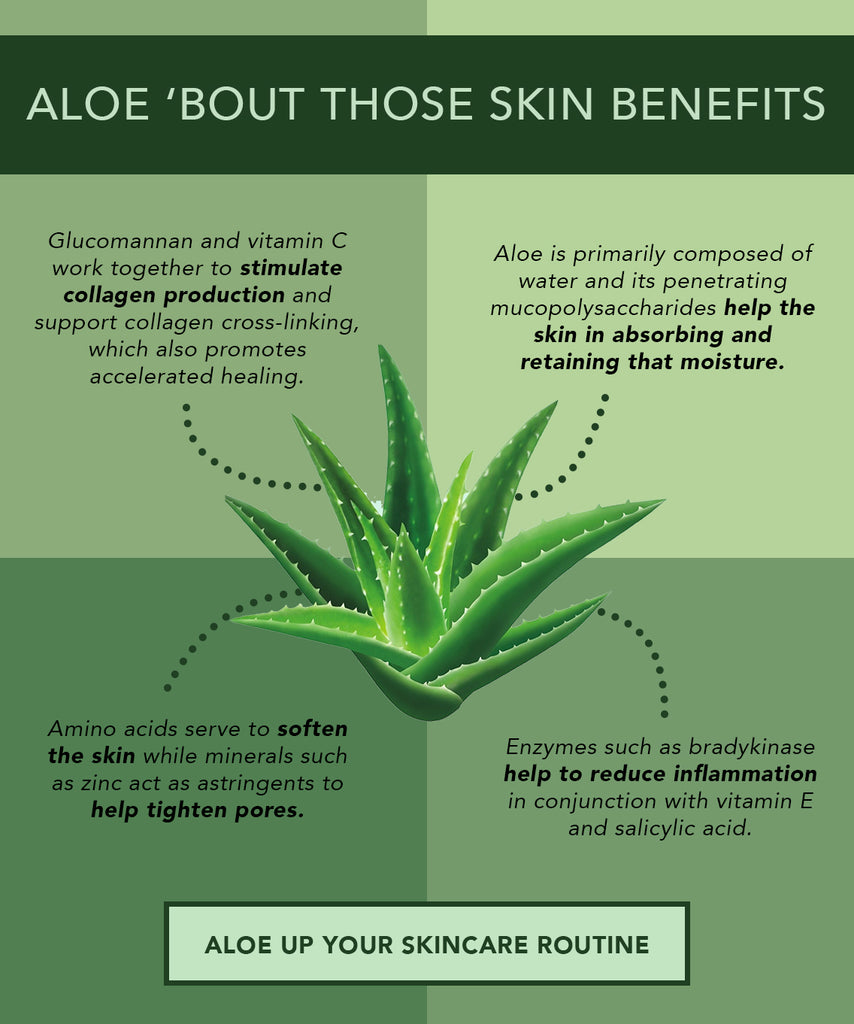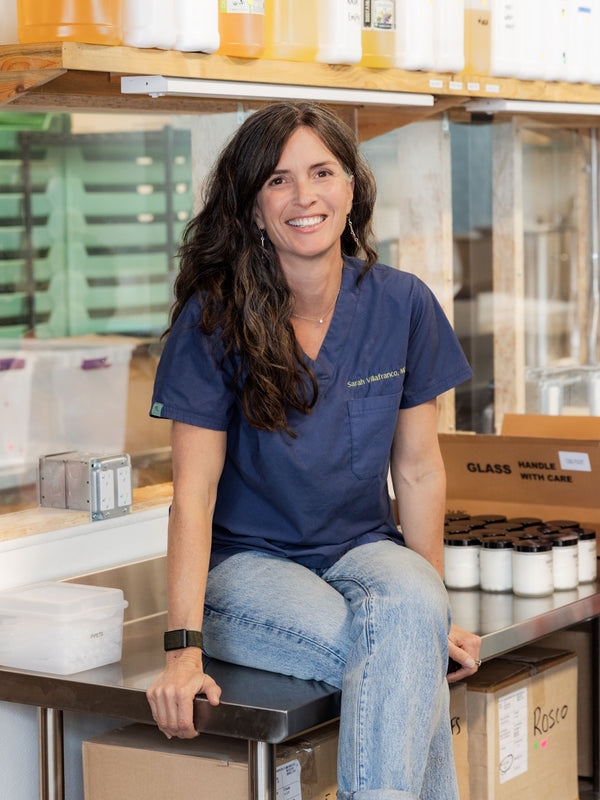Ingredient:
Aloe
What Is The Fancy Latin Name for Aloe?
Aloe vera, Aloe barbadensis miller
Where Did Aloe Come From?
The exact origin of Aloe vera is a rich mystery that is up for debate since it has historically been so widely traded and transplanted. The most commonly cited and supported theory is that it hails from the Arabian peninsula, but plenty of other locations boast their own endemic aloe species. The first known mention of aloe usage comes from a 2100 BCE Sumerian clay tablet, but it isn’t until around 1550 BCE that the earliest detailed description of its medicinal uses were recorded by the ancient Egyptians. It was traded across the Red Sea and Mediterranean region and touted by those living in the ancient world for its benefits in medicinal and skincare applications. Egyptian queens Nefertiti and Cleopatra gave their skin "the royal treatment" with aloe, while Alexander the Great used it on the battlefield to treat his soldiers' wounds. The modern day usage of aloe still falls mostly in those same two categories: cosmetics and healthcare. It's a staple in the natural skincare world, and has uses in wellness from digestion to wound care. Today, aloe plantations can be found around the world with the largest located in Thailand, the United States, China, and Australia.
Why do We Love Aloe?
The ancient Greeks were onto something with their regard of aloe as a universal panacea. Though not a true cure-all, aloe vera is one of the most commonly used medicinal plants in the world today. Its thick, spiny leaves are a rich composition of water, enzymes, vitamins, minerals, sugars, and amino acids that come together for some seriously synergistic healing.
What Are The Skin Benefits of Aloe?
- Aloe naturally contains salicylic acid, the active ingredient in aspirin, which may be one of the many reasons it helps with wound healing.
-
Glucomannan and vitamin C work together to stimulate collagen production and support collagen cross-linking, which also promotes accelerated healing. This is why so many brands, including Osmia, choose aloe for skincare products. It's the first ingredient in our whole Purely Line, which means it makes up a large percentage of those formulas.
-
Aloe is primarily composed of water and its penetrating
mucopolysaccharides, which help skin absorb and retain that moisture more effectively than water alone. -
Enzymes such as bradykinase help reduce inflammation in conjunction with vitamin E and salicylic acid.
- Amino acids serve to soften the skin while minerals such as zinc act as astringents to help tighten pores.
How To Use Aloe On Your Skin
Aloe in its raw form is easy to use! Simply snip a leaf from the plant, cut it (carefully) in half lengthwise, and scrape out the inner gel. You can mash it with a whisk until it's less chunky, and apply it directly to your skin and hair as a soothing treatment. One downside to using raw aloe is that it's actually a bit stinky! You can purchase aloe gel and aloe juice, but check for other ingredients, as they are often preserved with things you might not want to use.
Can You Eat Aloe?
Get creative in the kitchen with aloe vera! Its gel is rich in antioxidants and potentially beneficial for those with digestive issues, diabetes, and cardiovascular diseases. It is also packed with nutrients such as vitamin C and trace minerals of calcium, copper, magnesium, potassium, manganese, and zinc. Aloe vera gel has a clean, light, and refreshing taste that is easy to combine with other ingredients. The bitter, yellow latex of the aloe leaf should be thoroughly washed off any gel when preparing it for salsas, salads, or smoothies. This latex isn’t recommended for regular consumption since it is a powerful laxative and could lead to kidney damage. Aloe juice is the most common ready-to-consume aloe vera food product on the market, but some people make their own juice at home as well. Not feeling up to juicing or food prep? Plenty of supplements on the market use aloe vera gel for its many benefits in supporting overall health.
Remember, please do not eat aloe vera skincare gels. These gels are made for topical use only and often contain preservatives that are questionable for use on your skin, and definitely not meant to be ingested.

Fun Facts about Aloe:
-
The Caribbean island of Aruba was known as the “Island of Aloe” by the 1920s for its plantations and its coat of arms depicts an aloe vera plant.
-
Known as the “plant of immortality,” aloe was presented as a funeral gift to pharaohs.
- Need an inexpensive mouthwash? Aloe juice was shown in a randomized, controlled trial to be as effective as chlorhexidine (often prescribed by dentists) at preventing plaque and reducing gingivitis!
-
Aloe produces a clear gel, used mostly for skincare and wound healing, and a yellow “latex” that has a laxative effect when consumed orally.
-
Aloe vera is the most common type of aloe, but there are many—with names like spiral, snake, and sunset aloe.
- Aloe is one of the best plants for improving indoor air quality, and is especially useful when kept in the kitchen where it can be applied quickly to soothe a burn.
- Fresh aloe gel has a funky, slightly sour smell, so don’t be surprised if it doesn’t smell as lovely as our Purely Simple Face Cream!
In our products, we use certified organic aloe powder and reconstitute it with water to form the base for our Purely Gentle Mud Cleanser, Purely Calm Gel Toner, and Purely Simple Face Cream. It's one of our favorite skincare ingredients because it's simple and incredibly effective, and it's the first ingredient in all three products.
With love and healing aloe gel energy,

The information contained in this post is for educational interest only and is not intended to represent claims for actions of aloe. This information is not intended to be used for diagnosis or treatment of any physical or mental illness or disease.
Resources:
Gupta RK, Gupta D, Bhaskar DJ, Yadav A, Obaid K, Mishra S. Preliminary antiplaque efficacy of aloe vera mouthwash on 4 day plaque re-growth model: randomized control trial. Ethiop J Health Sci. 2014 Apr;24(2):139-44. doi: 10.4314/ejhs.v24i2.6. PMID: 24795515; PMCID: PMC4006208.
Sun Z, Zheng Y, Wang T, Zhang J, Li J, Wu Z, Zhang F, Gao T, Yu L, Xu X, Qian H, Tan Y. Aloe Vera Gel and Rind-Derived Nanoparticles Mitigate Skin Photoaging via Activation of Nrf2/ARE Pathway. Int J Nanomedicine. 2025 Apr 2;20:4051-4067. doi: 10.2147/IJN.S510352. PMID: 40191040; PMCID: PMC11972608.
Hekmatpou D, Mehrabi F, Rahzani K, Aminiyan A. The Effect of Aloe Vera Clinical Trials on Prevention and Healing of Skin Wound: A Systematic Review. Iran J Med Sci. 2019 Jan;44(1):1-9. PMID: 30666070; PMCID: PMC6330525.
Sánchez M, González-Burgos E, Iglesias I, Gómez-Serranillos MP. Pharmacological Update Properties of Aloe Vera and its Major Active Constituents. Molecules. 2020 Mar 13;25(6):1324. doi: 10.3390/molecules25061324. PMID: 32183224; PMCID: PMC7144722.
























